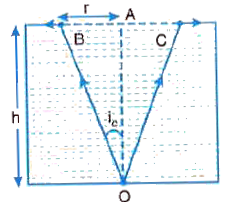A small bulb is placed at the bottom of a tank containing water to a depth of 80 cm. What is the area of the surface of water through which light from the bulb can emerge out? (Refractive index of water is 1.33. (Consider the bulb to be a point source)
As shown in Fig. 9.03 the light rays starting from a point object O (bulb in present case) situated at a depth h from surface of water can spread at the surface of a cone of semi-vertex angle ic equal to the critical angle of water.

Thus, AB = AC = r= h tanic, where h= 80 cm = 0.8 m
But by defintion sinic=1n=11.33=0.75
∴r=htanic=hsinic√1−sin2ic=0.8×0.75√1−(0.75)2=0.91m
∴ Area of water surface through which light can emerge out:
A=πr2=3.14×(0.91)2=2.6m2
Topper's Solved these Questions
- BOOK - U-LIKE SERIESCHAPTER - RAY OPTICS AND OPTICAL INSTRUMENTSEXERCISE - CASE BASED/SOURCE- BASED INTEGRATED QUESTIONS19videos
RAY OPTICS AND OPTICAL INSTRUMENTS
- BOOK - U-LIKE SERIESCHAPTER - RAY OPTICS AND OPTICAL INSTRUMENTSEXERCISE - MULTIPLE CHOICE QUESTIONS39videos
RAY OPTICS AND OPTICAL INSTRUMENTS
- BOOK - U-LIKE SERIESCHAPTER - NUCLEIEXERCISE - Self Assessment Test10videos
NUCLEI
- BOOK - U-LIKE SERIESCHAPTER - SEMICONDUCTOR ELECTRONICS : MATERIALS, DEVICES AND SIMPLE CIRCUITSEXERCISE - SECTION B1videos
SEMICONDUCTOR ELECTRONICS : MATERIALS, DEVICES AND SIMPLE CIRCUITS
Similar Questions
A small bulb (assumed to be a point source) is placed at the bottom of a tank containing water to a depth of 80cm. Find out the area of the surface of water through which light from thr bulb can emerge. Take the value of refractive index of water to be 4/3.
View SolutionA small bulb (assumed to be a point source) is placed at the bottom of a tank containing water to a depth of 80cm. Find out the area of the surface of water through which light from thr bulb can emerge. Take the value of refractive index of water to be 4/3.
View Solution
Knowledge Check
- Question 1 - Select One
A small bulb (assumed to be a point source) is placed at the bottom of a tank containing water to a depth of 80cm. Find out the area of the surface of water through which light from the bulb can emerge. Take the value of refractive index of water to be 4/3.
A2.6m2B3.6m2C4.2m2D5.8m2 - Question 2 - Select One
A small bulb is placed at the bottom of a tank containing water to a depth of 80cm. What is the area of the bulb can emerge out? Refractive index of water is 1.33. (Consider the bulb to be a point source.)
A3.13 m2B1.43 m2C2.61m2D0.88m2 - Question 3 - Select One
The refractive index of water is 1.33. What will be the speed of light in water
A3×108m/sB2.25×108m/sC4×108m/sD1.33×108m/s
A small bulb (assumed to be a point source) is placed at the bottom of a tank containing water to a depth of 80cm. Find out the area of the surface of water through which light from the bulb can emerge. Take the value of refractive index of water to be 4/3.
View SolutionThe refractive index of water is 1.33. What will be the speed of light in water
View SolutionA point source of light is placed at the bottom of a water lake. If the area of the illuminated circle on the surface is equal to 3 times the square of the depth of the lake. The refractive index of water is
View SolutionA coin at the bottom of a trough containing water to a depth of 15 cm appears to be 3.75 cm raised above from the bottom. Calculate the refractive index of water.
View SolutionA point source of light is placed at the bottom of a water lake. If the area of the illuminated circle on the surface is equal to 3 times the square of depth of the lake, the refractive index of water.
View Solution
